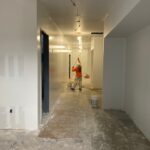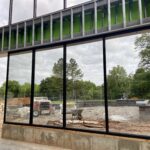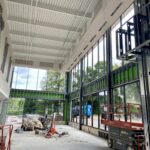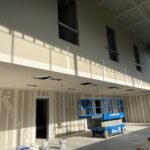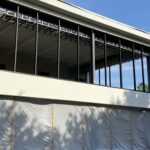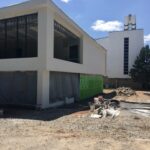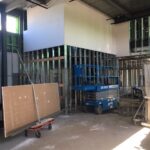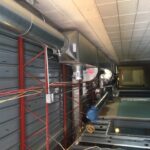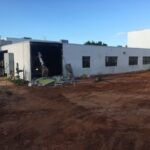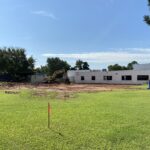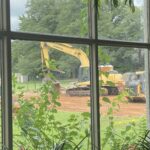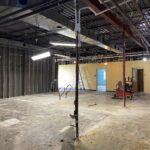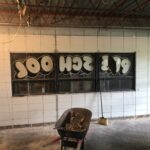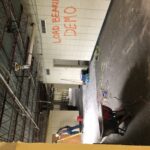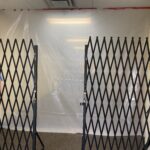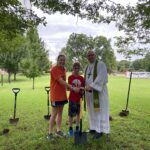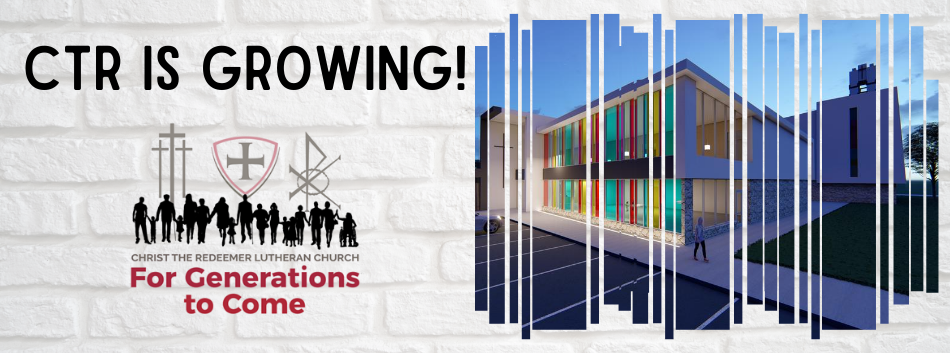
Construction Timeline
– Plumbing rough at walls is underway
– Electricians are beginning electrical rough at walls and ceiling
– HVAC contractor is continuing to rough in
– Fire suppression contractor is on site and has begun hanging pipe
– Paint is 90% complete with first coat in the existing building
– Excavation of the north patio and grading of the east parking area is in process
– Fire suppression to begin installing.
– Ductwork rough in is 65% complete.
– Sidewalk pouring at the northwest corner as weather allows
– Stair treads to second floor to pour as weather allows
– Framing to begin.
– Mud and tape continuing at existing walls.
– Paint at existing walls to begin .
– Plumbers continuing to rough in slab at existing portion of the building.
-Electrical demo is complete and new panels at existing building roughed in.
-Ductwork being installed at existing portion of the building.
-Demo has begun to bring down exterior of building & should wrap up early next week.
-Concrete contractor mobilizing mid to next week on column pads at existing building.
– Plumbers are saw cutting the slab and prepping to re-route plumbing at the existing slab.
– Electricians are re-working conduits in area to be demo’d and re-working 2″ line to panel.
– Interior demo wrapping up.
– Proof roll on building pad done August 20.
-Demo of building exterior tentative August 25.
-Re-location of exterior gas line at north end of the building to begin next week.

Our new addition will have a unique and colorful exterior, drawing from the color already on the windows in the sanctuary and welcome visitors and ECC families

This new multipurpose space will be shared between CTR on Sunday Mornings and ECC on weekdays.
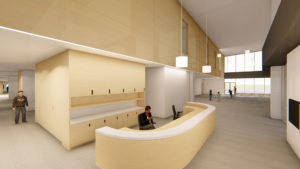
The new weekday entrance to the church will consolidate ECC and church visitors into a single entry flow for greater security

Our new SW entrance will lead worshipers directly into the Fellowship Hall and Narthex

This hallway will connect the SW entrance with the Narthex, giving visibility directly to the sanctuary for visitors. The Fellowship Hall will also be immediately accessible to the right. The small shelves to the left will be where name tags are kept.

This is how the current and new Fellowship Halls will be unified, and the remodeled kitchen will have a new separated wall so that clean-up will not disrupt events or meetings.

Offices for staff will be down a main hall across from the workroom and church reception
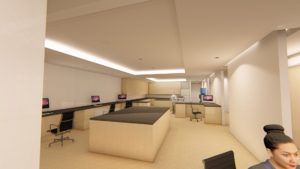
The new office workspace will have ample room for staff and volunteers to collaborate and see to the ministry of the church.

New rehearsal space on the 2nd floor will allow for access to the choir loft in the sanctuary from the elevator serving the upstairs offices.
Frequently Asked Questions & Answers for CTR Building Committee
1 – Why are we building?
This is obviously the biggest question for our whole church. The simplest answer is: to grow. The biggest need addressed in the building plan is to add room for growth in ECC, Education, Worship, and Fellowship. Additional space will enable more effective and efficient activities throughout our church as most ministries at CTR have found themselves adapting to increasingly limited space for ministry activity and resource storage. Key ministries like VBS, Youth, and ECC are at (or past!) the maximum limit for their service because of facility space constraints. As the building is expanded, we will also have the opportunity to refresh spaces to meet broader needs around modern building security, accessibility, and functionality.
2 – Why are we building where we are at?
The building committee reviewed at length the option of moving and determined that we likely could not afford to replicate our objective footprint on new land elsewhere in south Tulsa. Several market options and the related costs of new construction vs. renovation on a per square foot basis were evaluated as a part of this decision, but the option of staying in what is still a very good location for street traffic and enhancing the existing structure was a much better bang for our buck.
3 – What will the new building supply?
- 2 new ECC classrooms and a new ECC art & language center for all students
- A unified church business/ECC entrance for better security and more efficient resource sharing
- Elevator access to the balcony (and new music/church office space)
- A unified and renovated education wing for all age groups
- An expanded kitchen and fellowship space
- A new shared use space which could easily accommodate large group meetings, classes, and contemporary worship events
- Secured access points between the church and ECC spaces
- Significant amounts of new storage for elimination of clutter
4 – Why is the staff moved into the 2nd floor?
One of the biggest risks to both the church and the ECC is how visitors and vendors are granted access to the building during the week. Because the ECC and the church office use different entrances and separate door access/camera systems, often little or no effective screening occurs, which is a clear risk and has been something that DHS has identified as a concern in their inspections of the ECC. Also, because the ECC is on the other side of the building from the office, little staff interaction with the ECC teachers and families occurs, which is a gap from both a ministry and operational perspective. The best outcome is a unified system and entrance with workspaces that are very close. Our architect, in looking at options and overall project needs, identified using a 2nd floor space for church staff which was next to music/worship space (where the music director would be) and just above where the ECC operates would be a the ideal way to address the operational and ministerial gaps.
5 – How much will it cost?
The building committee, in consultation with the LCEF, originally set the project budget at a target of $3 million. Depending on various factors, the plan as designed will cost between $3 and $4 million. This represents a number of costs including construction, design consultation and project management, temporary space facilities used during various phases of construction, permitting, an average cost per square foot of both renovation and new construction activities, and the costs to address concerns on the roof. The building committee, under the guidance of the board of directors, is actively involved with the development of all financial evaluations, which will grow more detailed and specific as schematics are developed and the direct costs of materials and labor are calculated. Expect more specific answers to the this question as the project moves forward.
6 – What about the roof?
The basic problem with the roof is that its flat and thus does not drain as well as it ought. The building committee, with the consultation of roofing firms, our construction manager, and architects, has developed a basic strategy of adding small amounts of slope in various places to enhance drainage and prevent further leaks. While we anticipate addressing the addition of this feature to both the existing roofing and new roofing, we may be better off in handling this as a separate project from the bigger renovation and construction. As we get closer to finalized planning for the expansion, which parts of the roof would still need repair will be identified for work funded from the overall project resources.
7 – I hear that the entrances will be changed. How?
We will be keeping all 4 entrances to CTR, but 3 of the 4 will be renovated significantly and a 5th will be added.
- A new weekday business entrance will be part of the new construction at the north east entrance where the ECC currently goes out the playground.
- The main church entrance on the south west corner will be renovated significantly, removing the current covered entrance and instead opening an extended walk up with benches and a stone façade to doors that would open roughly where the fellowship hall is now. This entrance will align with the west wall of the sanctuary so that visitors can see directly into it and have a clear path inside the building on Sunday mornings.
- The north west entrance near handicap parking will be given a new covering and roundabout to support easy access to the sanctuary, even in weather.
- There will be a new smaller entry where the church office is now for direct access to education space and for fire safety in that area.
- Finally, the ECC entrance on the south east corner will remain unchanged, though less used going forward.
8 – If we build toward 71st, what happens to the playground?
There are several options we have for the playground, relocating it either close to the front or further to the rear of the property. Both have pluses and minus. Presently, the ECC is leaning toward a new playground in the back of the building near where the shed currently sits with a new dedicated walkway from either of the eastern entrances. The playground is fundamentally a fairly flexible space requirement so we are not finalizing the plans at this point while comments and consideration are ongoing.
9 – Will there be an elevator? What other accessibility additions will be in the new building?
Yes – there will be an elevator along with a new set of straight stairs to the second floor. These will give easy access to the office and the new music rehearsal/storage space which has a new entrance to the balcony. We will be keeping the current spiral stairs as well for direct balcony access from the Narthex, as well as their distinctive and historical significance. Further accessibility enhancements will include new, full size bathrooms that will be added to replace the current small ones near the sanctuary/across from the kitchen. We also see the added covered walkway to the north west entry will be an accessibility benefit since it will supply covered access nearer to handicap parking without the need for use of the steeper ramped sidewalk currently by the covered south west entry.
There was much consideration given as well to adding accessibility in the sanctuary in the form of a ramp up into the nave. The guidelines for accessible ramps and the height of the platform unfortunately lead to no feasible designs for this in the sanctuary, without the removal of several rows of pews.
10 – Why aren’t we doing anything to the sanctuary?
Actually, we are making changes to the sanctuary, though you might miss the from your spot in the pews on Sunday morning. The needs for the sanctuary, as they were communicated by staff and ministry leaders (most notably the worship ministry) were generally focused on the challenges posed by the balcony space. These needs were addressed not by adding space the the sanctuary itself, but by adding space next to the sanctuary on the new second floor which would allow for musicians and AV volunteers to better manage their activities, namely by providing new storage outside the balcony. Depending on the project funding additional enhancements in basic needs (flooring, pew repair, sound/acoustics) may be included.
11 – Why aren’t we adding more parking?





